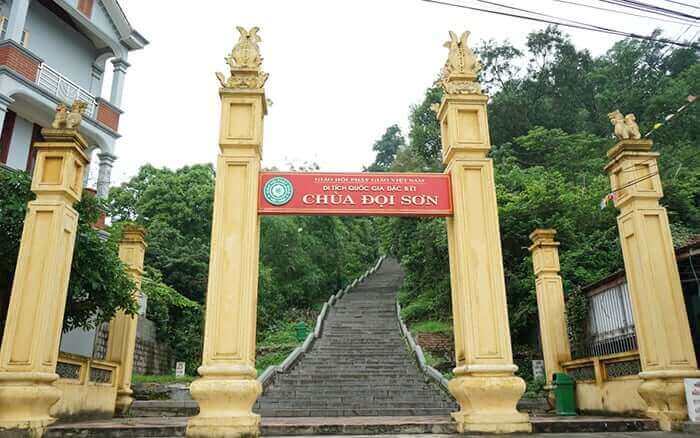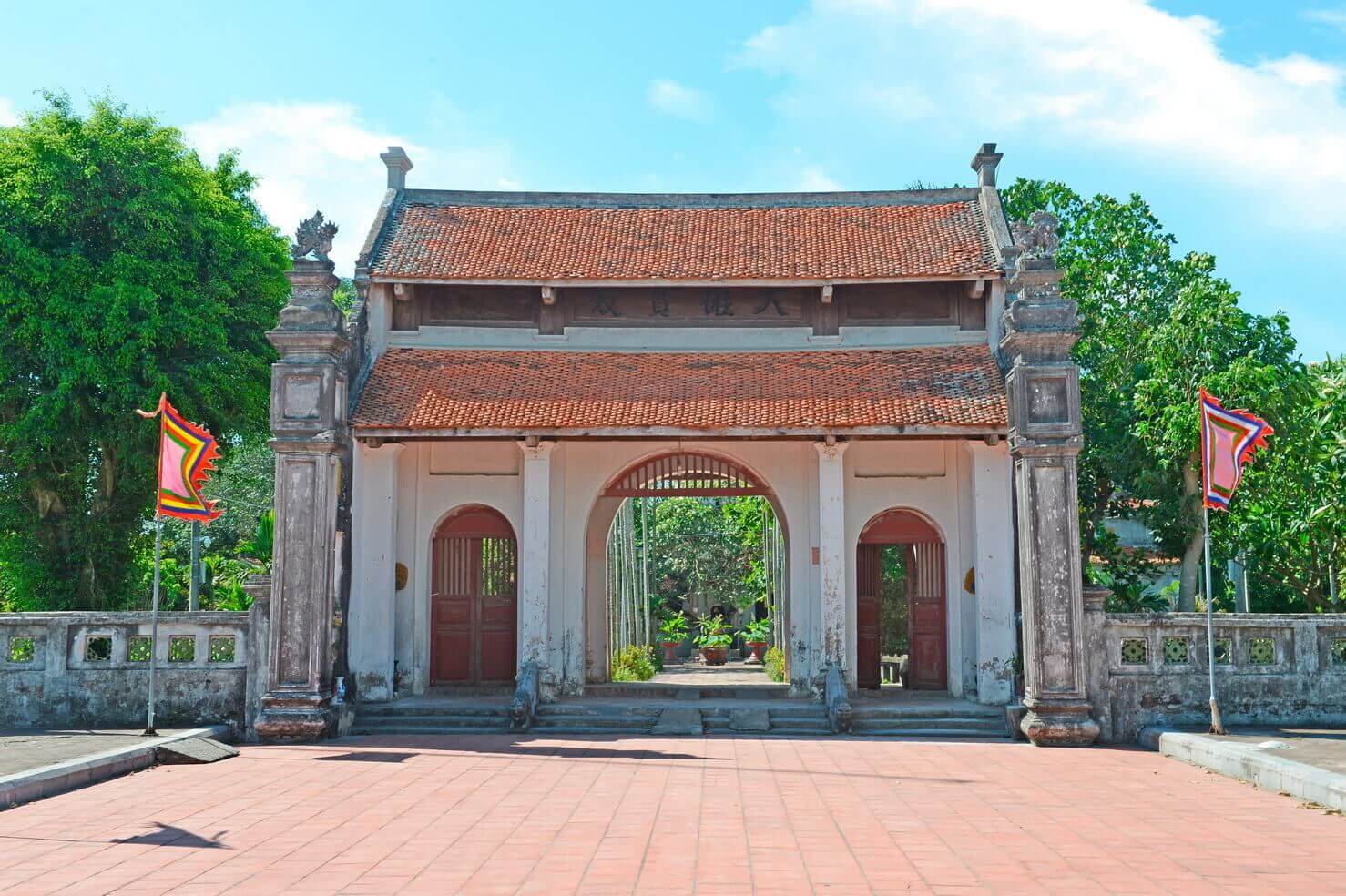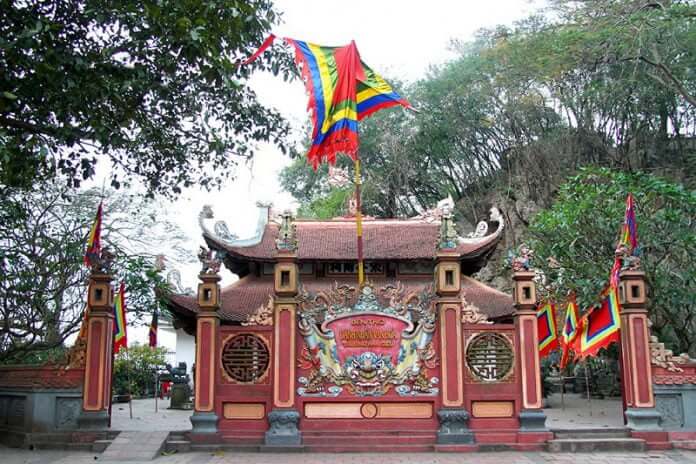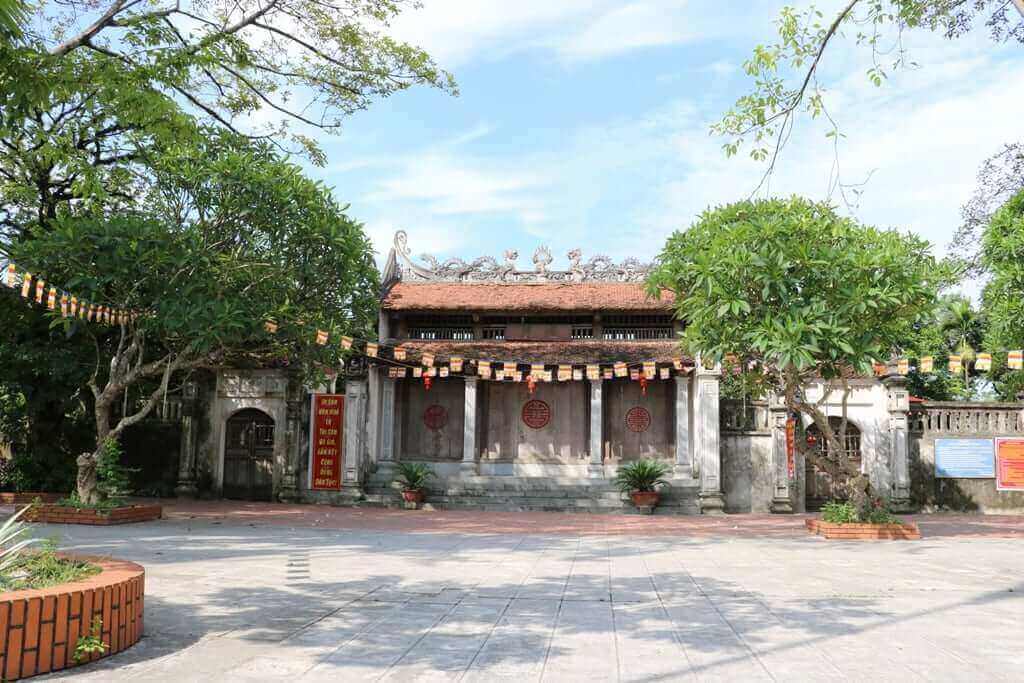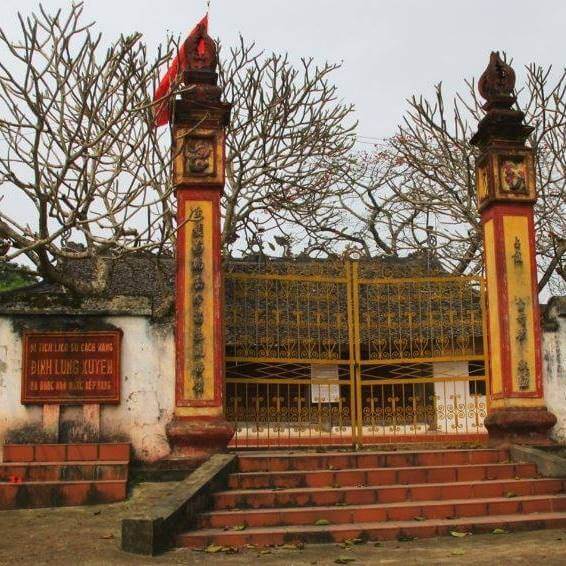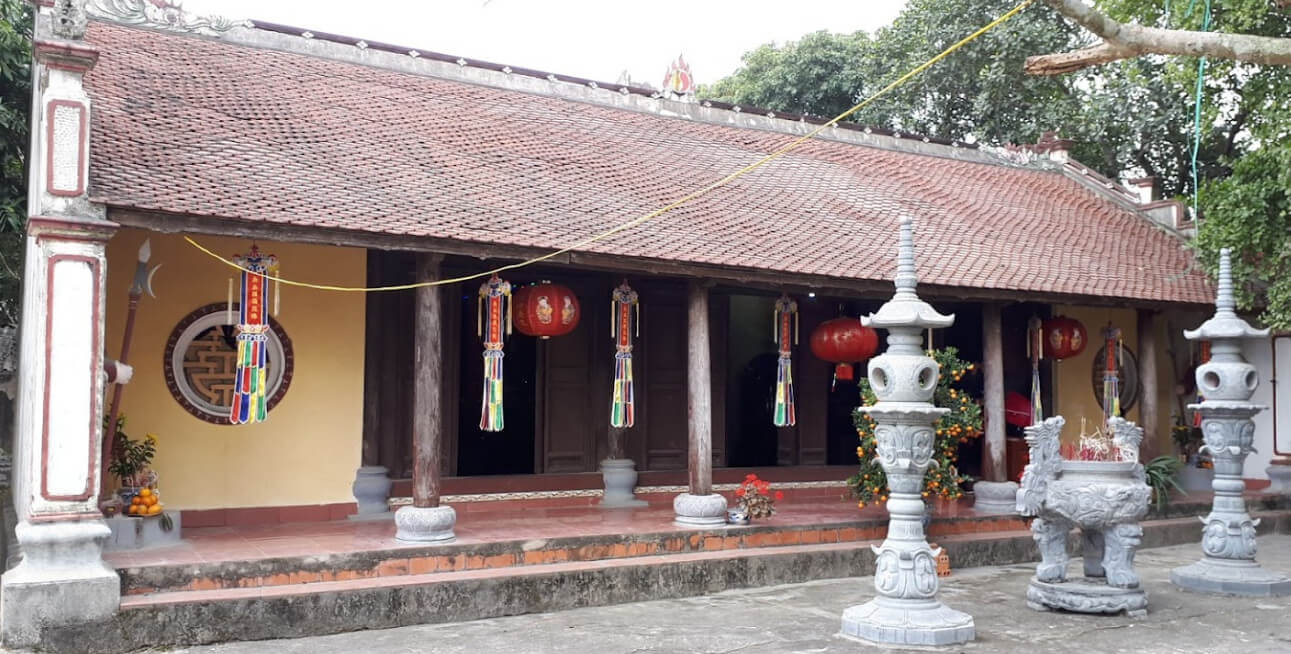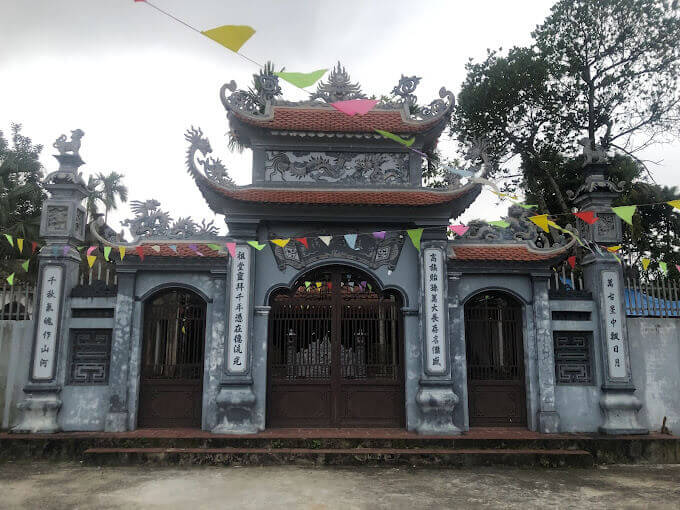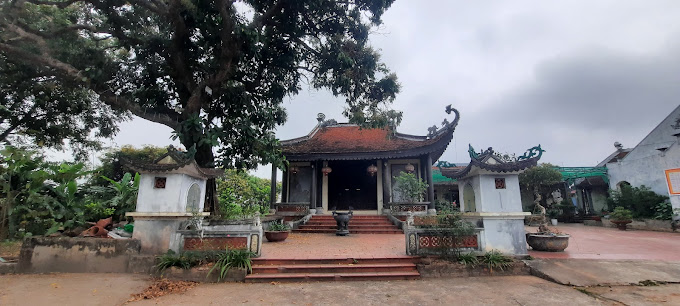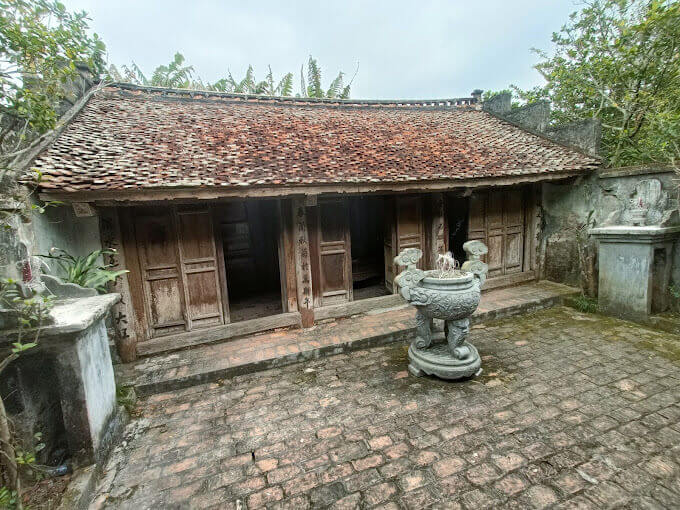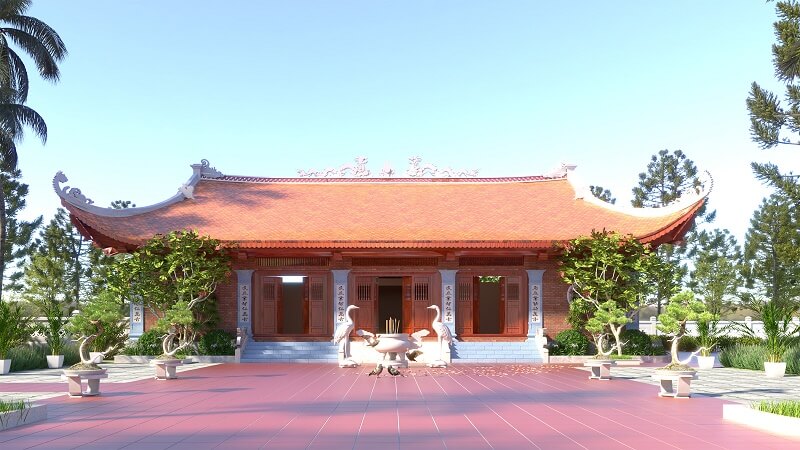Relic point Vietnam
Việt NamLong Doi Pagoda (Doi Son)
Doi Son pagoda relic complex, Doi Son commune, Duy Tien district, Ha Nam province, ancient Son Nam town. The pagoda was built on top of Doi mountain, within 2 hectares of forest garden. According to written historical records and related legends, Doi Son Pagoda was originally a small temple that existed from the 10th to 11th centuries. During this period, the pagoda was associated with the name of the monk Dam Cuu Chi, who was the master of the temple. Replace the bamboo and thatch architecture of the past to build pagodas with bricks and tiles, a more sustainable material. In the 12th century, King Ly Nhan Tong, on his way through here, saw that the scenery was still there but the pagoda was in ruins, so he rebuilt the pagoda and erected the Sung Thien Dien Linh tower. Construction began in 1118 and was completed in 1121. From then on, Doi Son Pagoda became a great landscape and palace, one of the important Buddhist centers of the Ly Dynasty with the meaning of guarding the south of Thang Long citadel. Doi Son Pagoda has stood firm for more than 300 years. In the early 15th century, when the Ming invaders invaded our country, the pagoda and tower were completely destroyed. During the late Le, Mac, and Nguyen dynasties, Doi Son pagoda was continuously built and renovated, gradually restored with 125 compartments, built in the foreign internal style, including a hall of worship and heavenly incense. and the upper palace, two rows of corridors on both sides worshiping the Eighteen Arhats. During the resistance war against the French, this ancient pagoda was once again destroyed. After peace was restored in the North, the government and local people actively restored the temple. A major repair in 1958 completed the main works here. Through many ups and downs of history, the pagoda still retains its ancient and sacred features, imbued with the architectural and artistic style of the Ly Dynasty. This is a temple with a long history, reflecting a flourishing period of Buddhism in the nation's history and is the pride of the people here. One of the artifacts with outstanding historical and cultural value kept at Doi Son Pagoda today is the Sung Thien Dien Linh stele. The stele with unique carving art contains a lot of rare information for studying the history and culture of the Ly Dynasty. In particular, the Sung Thien Dien Linh stele is also the only stele that provides rare information about the Quang Chieu Light Festival in Thang Long citadel, the art of water puppetry, Buddhist rituals, and the repair of Dien Huu pagoda. (One Pillar Pagoda), the construction process of Sung Thien Dien Linh tower. Doi Son Pagoda is also one of the few pagodas today that still preserves many valuable Ly Dynasty art artifacts such as: Statue of Da Bao Tathagata, Vajra statue, statue of a human head and bird body (kinari) - works The product demonstrates the cultural interference between the two artistic architectures of Champa and Dai Viet during the Ly dynasty. Along with architectural items and a system of artifacts and worship objects, Doi Son Pagoda also preserves a rich, diverse and very valuable treasure of Han Nom heritage. This is a valuable source of material that has summarized the cultural quintessence of many dynasties, from folk knowledge to scholarly knowledge, and is a very unique asset with priceless value that few places can find. With a long history and many events, the pagoda also has strong archaeological value. In the excavation pit located between the pagoda's harem and the back house, the foundation, architectural materials and many Ly Dynasty artifacts such as decorative specimens, ceramics, crockery, and metal were found. The historical relic of Doi Son pagoda demonstrates the creativity in construction science, construction material production as well as exploitation techniques and taking advantage of natural conditions of generations of ancestors in feudal dynasties. with skillful construction techniques of wood, stone, and brick materials, creating architectural works of high artistic value. With the above typical historical and cultural values, on December 23, 2017, Doi Son Pagoda relic, Duy Tien district, Ha Nam province was signed by the Prime Minister and ranked as a special national monument. special. Source: Ha Nam Electronic Newspaper
Ninh Binh 4264 view
Pho Minh Tower Pagoda
Pho Minh Pagoda, whose name is Pho Minh Tu, is a pagoda located in Tuc Mac village, Loc Vuong ward, Nam Dinh city. Based on the ordination stele as well as ancient bibliographies, the pagoda was built during the Ly dynasty, and in 1262 the Tran dynasty expanded to a more grand scale. In 2012, Pho Minh Pagoda was ranked by the Prime Minister as a special National Monument. Because in front of Pho Minh Pagoda there is a tower, the pagoda is also known as Chua Thap, the Tower is also known as Pho Minh Tower. Pho Minh Tower is a unique architectural work. This is the largest, oldest and most intact tower in Vietnam. The book Nam Dinh Province Geography by author Khieu Nang Tinh records about the pagoda as follows: "During the Tran Dynasty, King Nhan Tong restored his residence as a monk. When the king died, Anh Tong built a 14-storey tower, 53 meters high, with 10 meters on each side to house the relics. During the Tay Son period, the governor of this region broke the top of the bronze gourd tower. When we reached the 13th floor where the stone was, we saw an object shaped like a red ribbon flying into the sky, so we stopped destroying it..." In addition, among the people, there is also a saying of Buddha Emperor Tran Nhan Tong: “No matter who competes for the throne I would like to send back this handful of temple bones." Therefore, researchers believe that this is a tomb tower. Currently in the country there are only three towers built during the Tran Dynasty: Pho Minh tower (Nam Dinh), Hue Quang tower (Yen Tu, Quang Ninh) and Binh Son tower (Lap Thach, Vinh Phuc), but Pho Tower Minh is still the more majestic tower, with the most elaborate, artistic, and technical construction. The tower was built right in front of the worshiping house on the North - South axis. The tower has a total height of 19.51m including 1 palanquin and 13 floors. The tower is built on a small square yard, each side is 8.6m and located 0.45m lower than the ground. The palanquin is the base of the tower designed entirely of green stone, each side is 5.20m long. At the foot of the tower there is a lotus flower with large petals and small petals, gradually tilting towards the corner of the tower from the middle, symbolizing a lotus platform holding a palanquin. The lower part of the stone pedestal is shaped to curve up on both sides, making people mistakenly think it is due to the rock sinking, but in fact, the construction was intended to create momentum for the more than a dozen floors above to have the same curvature. Looking at the entire tower, people will think of a Lotus flower rising and blooming in the middle of a lake. From the palanquin and above, there are 13-storey towers built of red bricks with 4 gates: East, West, South, North. Previously, all the floors had exposed Dragon motifs and beautifully decorated flowers and leaves. The higher the tower floors went, the smaller the height and width of the tower's face became. At the top of the tower was a cube with the shape of an unbloomed lotus flower made of old terracotta. Unfortunately, in the early years of the twentieth century, when repairing the tower, people placed a coat of cement material on the outside of the tower, causing the patterns on the bricks to be lost. In 1987, because some of the upper tower floors were cracked by tree roots, the cultural sector repaired and restored them. During the renovation process, people discovered that on the 11th and 12th floors of the tower, there was a stone sarcophagus surrounding a bronze box, which according to people's legend, could be the box containing the relics of Buddha Emperor Tran Nhan Tong. . Pho Minh Tower has existed for 7 centuries. Despite experiencing many storms and natural disasters, the tower is still preserved almost intact, becoming a rare wonder that makes it unique not only for the city. Pho Minh Pagoda but also Nam Dinh province in general. Source: Management Board of Historical-Cultural Relics Tran Temple and Thap Pagoda
Ninh Binh 5122 view
Temple of Truong Han Sieu
Truong Han Sieu Temple is located in the southwest of Duc Thuy Mountain, one side leans against the mountain, below is the lyrical Day River lazily flowing, winding from right to left, embracing the Temple area, creating a lyrical scene. , peaceful yet majestic. Truong Han Sieu (year of birth unknown) is from Yen Ninh district, Truong Yen district, now Ninh Binh city, Ninh Binh province. He was talented in literature and martial arts, rich in patriotism, and was respected by the kings of the Tran dynasty. Together with Nguyen Trung Ngan, he composed the Code of Laws "The Thuong Thu" and the book "Royal Trieu Dien", laying the foundation for the Vietnamese feudal regime to operate according to the law. When he died, he was posthumously awarded the title of Deputy Thai Viceroy and worshiped at the Temple of Literature - Quoc Tu Giam. When he died, a temple was built in the Southeast near his grave. But over time due to war, Truong Han Sieu temple was leveled. In early 1993, during the construction of houses in Van Giang ward, city residents discovered stone tablets and stone steles, column bases, and stone steps of the temple buried deep in the ground. On April 24, 1998, the construction of Truong Han Sieu temple officially started in the southwest area of Duc Thuy mountain. Truong Han Sieu Temple has a nail-style architecture, including 3 Bai Duong compartments and 2 Harem compartments, two floors of roofs covered with taro tiles, and the corners have curved knife heads. Looking at the edge of the roof, it rolls up at both ends like the image of a spectacular dragon boat. On the roof of the temple are two dragons flanking the moon. The front of the temple has a large inscription in Chinese characters "Truong Thang Phu Tu". Inside the altar is a bronze statue of Truong Han Sieu with a 1:1 ratio, sitting on a pedestal in Tran Dynasty costumes. The altar has a hammock door, an incense burner and two shelves with precious bowls on both sides. The last room of the harem has an incense burner to hold Truong Han Sieu's tablet. Every spring, Truong Han Sieu Temple is also a place where a large number of people in the province come to burn incense, sincerely ask for the New Year's blessing, with wishes for good things and luck in the new year. Truong Han Sieu Temple is located right next to Non Nuoc Mountain, one of the most famous tourist destinations in Ninh Binh. The temple worships Truong Han Sieu - a cultural celebrity and also a son of Ninh Binh. He was a man of "literature and martial arts", and together with scholar Nguyen Trung Ngan, composed the "Hinshu" law code. The Temple of Truong Han Sieu will always be living documents for generations to come. If you visit the ancient capital, don't forget to visit Truong Han Sieu temple to learn more about the roots of Vietnamese history. Future generations need to preserve cultural relics of historical significance because this is not simply preserving ancient architecture but is also related to the cultural history of an entire nation. Source: Electronic information page of Ninh Binh Department of Tourism Information Center
Ninh Binh 3738 view
Ba Danh Pagoda
Ba Danh Pagoda - Ngoc Mountain is located in Danh Xa village, Ngoc Son commune, Kim Bang district, Ha Nam province. Ba Danh Pagoda is also known as Bao Son Pagoda. In addition to worshiping Buddha, Ba Danh Pagoda also worships the Four Dharmas (Phap Van, Phap Vu, Phap Dien, Phap Phong which are Cloud God, Rain God, Thunder God, Lightning God) a worship of nature very close to life. agriculture in our country. As for the name of Ba Danh pagoda, according to local legend, the pagoda worships the sacred goddess who oversees the control of rain and wind, helps people eliminate floods, brings good rain and good harvests, so it is called Ba Danh pagoda. Notre Dame Pagoda in Danh village, abbreviated as Ba Danh Pagoda as it is called today. Passing the rather majestic Cam Son suspension bridge over the Day River, going up a deserted dike road, you will see a stone sign that reads "Cultural and historical relics of Ba Danh Pagoda and Ngoc Mountain". Three-entrance gate. The pagoda's construction is quite majestic and majestic. The gate has three compartments, two floors, above is a bell tower, below is a system of wooden doors with simple patterns. However, this gate only opens when the pagoda has a grand ceremony. On normal days, visitors have to go through two small gates on both sides with curved tiled roofs like a semicircle. Stepping through the half-closed gate is a spacious campus, tiled very cleanly. In the temple grounds, there are many places. Bonsai pots, orchid baskets and especially tall rows of spindly areca palms. Similar to the architecture of many pagodas in the Northern Delta, Ba Danh Pagoda is a continuous architectural complex including the worshiping house, the upper house, the middle house, the Mausoleum worshiping house, the ancestral house..., and the temple belongs to the sect. This Mahayana Buddhism has its own unique features. In the pagoda, there are not only Buddha statues but also Taoist statues such as Thai Thuong Lao Quan, Nam Tao, Bac Dau, statues of Tam Phu, Tu Phu, and Phap Vu. If you come to visit and admire the pagoda, you should take the time to admire the statue of Ba Danh, carved in a meditating position on a shiny black throne with a beautiful, gentle, feminine, close and friendly face. set. The harmony between the statue and the throne creates the attractiveness of Ba Danh pagoda's sculpture art. In 1994, Ba Danh Pagoda was recognized by the Ministry of Culture, Sports and Tourism as a national historical site. For many years now, people have no longer seen the deserted and lonely scene at this pagoda. The previous sentence "as deserted as Ba Danh Pagoda" has now been changed to: "In the past, it was deserted and desolate. Now it is bustling." like Ba Danh pagoda"... Connecting Ba Danh Pagoda and Ngoc Mountain is a large field planted with perennial trees, mainly lychee and longan, but also corn and rice depending on the season. Located completely isolated from residential areas, on mountains, under rivers, near temples, near pagodas, Ngoc Mountain is truly a scenic spot of Kim Bang land, an attractive tourist destination. Ba Danh Pagoda is widely known not because this pagoda is crowded with pilgrims or tourists, but this relic is known by the simile "As empty as Ba Danh Pagoda". Source: Electronic Information Portal of Kim Bang District, Ha Nam Province
Ninh Binh 4495 view
Lung Xuyen Communal House
Lung Xuyen communal house is located in Lung Xuyen village, Yen Bac commune, Duy Tien district, Ha Nam province. Lung Xuyen communal house worships national hero Ly Thuong Kiet. According to local legend, the Chau River flowing through Lung Xuyen is the waterway that Ly Thuong Kiet and his warriors often traveled back and forth when stationed in the lower Thinh Chau and An Xa regions. During past patrols, he and his soldiers once rested here. Around Lung Xuyen village, there are also many mounds. Legend has it that this is the place to tie war boats and store supplies of the armies led by Ly Thuong Kiet. Local people believe that Ly Thuong Kiet came from Thang Long, followed the Red River, entered the Chau River (with a stay at Lung Xuyen), and then went to the Day River. Currently, at the communal house there are still many eulogies praising the merits and virtues of the Captain. In the two palaces, there are also words engraved on the crossbeam of the first rafter adjacent to the front hall "Phat Tong Binh Chiem, peace of the people". forever", is to praise his great contributions to the country. The communal house was built on a large, high, airy piece of land. The communal house faces south and is built in the style of "Ding" with 5 compartments in the front hall and 3 compartments in the back palace. The front hall is 17 meters 20 meters long, 8 meters 80 meters wide, curved roof, male tile roof, lined up, straight, dragon claw style roof tiles. The front of the front hall is a row of table doors, the frame is made of thread edges, and in the middle is a panel-style board. Both sides are built with brick walls, in the middle of the wall there are two windows. The two rows of columns in the front hall are made of buds, with a large middle and two small ends, placed on a square green stone, with a round mirror floating on the stone surface corresponding to the diameter of the column's base. The roof still retains a number of round diaphragms with a diameter of 12cm. Later restorations added many square diaphragms with sides of 12cm. The 3-compartment harem connects the roof with the middle compartment of the front hall. The middle door of the harem has a plaque carved with two flanking dragon horses, tiger faces with feet holding the heads of two dragon horses. Below the carving is a great painting engraved with four large Chinese characters: "Son Xuyen Chung Tu" (Beautiful light with rivers and mountains). In the communal house's yard, there is also a system of bronze pillars, including a base built in a high-necked style, the pillar body is embossed on four sides, above is a lantern and on top is a shaft supporting two large gardenias. Next is the left gate and the right gate, each gate has 4 curved roofs with knife heads and pipe tiles. In the yard are two rows of algae houses, each row has 3 rooms used to welcome guests during festivals. Here, on the night of August 19, 1945, the main force of the revolutionary army to seize power of the district gathered to wait for the order to depart. Early in the morning of August 20, 1945, at Lung Xuyen communal house, 3 armed squads of the district took an oath before the national flag, then marched according to the planned plan. Previously, Lung Xuyen communal house had many beautiful worship objects. Through the years of war, many artifacts were lost. Currently in the harem, only the throne worshiping Emperor Ly Thuong Kiet is typical, the throne is 1.1m high, carved on the body and arms of the throne. In the harem, there is also a small bell 50cm high, 30cm bottom, the handle of the bell shaped like two dragon heads and one body. In addition, Lung Xuyen communal house also has a bronze three-piece set including incense burners and two candles. The incense burner is 50cm high, has a gourd-shaped body, has two handles attached, 3 legs shaped like a cup, and the lid is shaped like a smiling calf. The above artifacts contribute to the cultural value of Lung Xuyen communal house. Source: Ha Nam Province Electronic Information Portal
Ninh Binh 4622 view
Lang Dau Communal House
Dau village is also called My Doi village, located in An My commune, Binh Luc district, Ha Nam province. Located in an area with a rich history. Here, three sisters A Dao, Nguyen Phuong, and Nguyen Que are worshiped, who commanded the insurgents to fight the Ming invaders in the early 15th century. According to Ngoc Dinh Dau family tree and local legend, the father of the A Dao sisters came from Tien Lu area, Hung Yen, to Bo Xa Binh Luc commune, married a concubine, Thi Huong, and gave birth to A Dao, Nguyen Phuong, and Nguyen Que. At that time, the Ming invaders invaded our country, killed lives, looted property, and caused many tragedies in Trang Co Tho (now An My commune). Faced with the tyrannical actions of the Ming enemy, A Dao discussed with the two children and the villagers to find a way to fight the enemy and eliminate harm to the people. The insurgents of Bo Xa and Co Tho villages decided to attack the Minh enemy base. At midnight on February 14, A Dao divided his army into three groups, coordinating with the villagers of Co Tho to attack and destroy the enemy post. Before departure, the insurgents used banh day as food, used sugarcane as water and absolutely did not use fire. The raid successfully destroyed the enemy post. The people of ancient Tho were liberated and regained peace in their villages. To remember the gratitude to the heroes who saved the people and the country, local people set up temples on the marching routes. Therefore, Dau village has three small temples on three sides, each temple worships a general such as Princess A Dao, King Nguyen Phuong, King Nguyen Que. The people of Dau village also built a large communal house with a curved roof, with elaborate sculptural work, to serve as a place for the community to worship the deities who, over the ages, were all ordained with good words. The special thing is that the village takes February 15 to perform, "Destroying the Minh Binh post, revealing the legend" (opening the demonstration of the legend of attacking the Ming enemy's post). In addition to the above legend, Dau village communal house also worships two Doctors, Bui Cong Bang and Bui Cong Minh. The two doctors of the Le Dynasty made a name for themselves and were symbols of the studiousness of the people of Dau village. During the Ho Chi Minh era, Dau village was also a "red address", where heroic pages of history of the Party Committee and people of Binh Luc district were written. In 1930, the Party cell of My Tho commune was officially established at the temple area in the relic complex of Dau village; started the stubborn struggle movement against French colonial domination. Dau village communal house and elite party members of the homeland protected and protected many senior revolutionary soldiers such as comrade Hoang Quoc Viet (Northern Party Committee), comrades Tran Tu Binh, Pham Mong Sach, and Ca. All... when these comrades returned to lead the revolutionary movement in Ha Nam. In the years 1950-1954, many times Dau village guerrillas surrounded and attacked enemy positions on Route 21, as well as surrounding posts. In March 1954, Company 37 of Ha Nam province and Company 60 of Binh Luc district raided the 9th French battalion, causing them many losses. With the historical and cultural values of Dau communal house and its spread to the heroic revolutionary struggle tradition of the local people, the State has decided to recognize Dau communal house as a historical relic. national level culture; Source: Electronic Information Portal of Binh Luc District, Ha Nam Province
Ninh Binh 4974 view
The temple worships National Cong Tran Nhu Lan
From Luong street (church) of Cong Tran Nhu Lan in Thuong Lang village, Ngoc Lu commune, Binh Luc, Ha Nam. This church was built by the family's children, grandchildren, and great-grandchildren in the 2nd year of Chinh Hoa (1681) 46 years after Cong Tran Nhu Lan passed away. The 5-compartment house is made entirely of ironwood, each truss has 4 columns, the main column has a diameter of over 30cm, all column bodies are placed on green stone bases, 3 sides of the church are built with brick walls, in front is a system of ironwood doors running through 5 compartments that can be easily assembled and disassembled. The outer surface of the two upper gables is covered with tiger balm, in front, close to the gable ends, are two copper pillars, making the house more spacious and grand. . All are roofed with male tiles. The roof edge on both gables is covered with 2 needles. These symbols easily show people that the characters worshiped here are more martial than civil. At the Church of the Duke, there are also many diverse worship objects including many types of materials such as wood, precious metals, ceramics, stone, fabric... All wooden altar objects are painted with gilded vermilion, brilliant color. In particular, 15 ordinations from the Later Le Dynasty are still preserved here. The earliest religious record was on December 5, 1769 (the 5th year of Vinh To). Appointed the Duke of Left Admiral Tieu Bao, the most outstanding minister of the country, Tran Nhu Lan. The last ordination was given to Tran Nhu Tiep (7th generation of the Tran Nhu Lan family on July 19, 1769) in the 30th year of Canh Hung). At the church, there are also epitaphs and genealogies from more than 300 years ago, which help a lot in researching the past history of our homeland. Through preserved documents and legends in the area, it is recounted: Tran Nhu Lan was born in 1563 in Kim Lu village (now Ngoc Lu commune, Binh Luc district) into a poor farmer family. His biological father died early and living in a widowed and orphaned situation, he soon had a sense of autonomy to shoulder all the family chores left by his father. From herding buffaloes to collecting firewood to work for hire, he did not hesitate. He was also passionate about practicing martial arts and learning, which helped him have great intelligence and extraordinary health. At this time, the country's situation was chaotic, divided, people were divided, and the people were miserable because of the constant civil war. Tran Nhu Lan, who had a strong and heroic personality, wholeheartedly supported the king and helped the country and its people. Whatever is assigned is completed. For his homeland, Tran Nhu Lan and his descendants always wished for their homeland to change for the better. He and everyone helped repair village communal houses and Buddhist pagodas, renovate and expand Kim Lu market (Chu Chu market). He also built roads, built bridges and culverts, set up ferry wharves for people to travel easily, and encouraged people to declare. destroy waste land to improve lives, buy more land for villagers to cultivate to take care of common matters. Name some hamlets and fields of the village. Organize some annual village activities. From his practical contributions to his homeland, he was respected and worshiped by local people as a village god while he was still alive. After his death, every year in spring and autumn, when the village held festivals, he also enjoyed offerings at the village communal house. Currently, Ngoc Lu pagoda also has many statues of queens who are the wives of the Tran Nhu family. Due to many contributions of money and land during the temple's renovation, they were carved to worship (There are 6 statues). female). From Luong Street, Tran Nhu Lan District was ranked as a national historical relic on January 16, 1995. Source: History of Tran Nhu Family
Ninh Binh 5324 view
Co Vien Communal House and Pagoda
Co Vien communal house and pagoda are located in Hung Cong commune, Binh Luc district, Ha Nam province. Co Vien Communal House is a large-scale architectural work consisting of 4 buildings made in both domestic and foreign styles. Although it has been repaired and embellished many times, the monument still retains the artistic lines of the 17th and 18th centuries. In addition to creating solid durability, the architectural structures on the building are also carved. Many vivid themes bearing the sculptural style of the Later Le period such as flanking dragons, dancing phoenixes, leaves turning into dragons, dark clouds, and fire leaves. Along with the beauty of Co Vien communal house's architecture, a number of worship objects with artistic value are also preserved. It is a fairly large desk placed in the middle of the front hall with a unique appearance, reasonable pattern layout, decorated with many folk themes with coherent carved and embossed lines. At the main communal house, there is an altar that is a work of art from the Later Le period. In addition to being decorated with many themes and motifs with elaborate carving techniques, the altar is also covered with a splendid layer of gold, contributing to the solemn atmosphere of the place of worship. Co Vien Pagoda is located adjacent to Co Vien communal house, the literal name is "Linh Quang Tu" (Linh Quang Pagoda). The project consists of 2 main buildings, 8 rooms designed in a nail style, with a flat roof covered with male tiles. In addition, behind there is a 5-compartment ancestral house, in the west is a 5-compartment worship hall with the architecture of the front and back. According to local legend, the pagoda was built during the Ly Dynasty. However, due to time and the influence of natural conditions and war, Co Vien Pagoda has been repaired many times, and now the architecture of the building is completely in the artistic style of the Nguyen Dynasty. Based on the book, Geography of Binh Luc district, Co Vien communal house is the place to worship Nguyen Hoang, general of the Hung Due Vuong period. Nguyen Hoang was proficient in literature and martial arts from a young age, so when he reached adulthood, Nguyen Hoang was recommended to the court by Tan Vien Son saint. Appointed as General Dung, he often escorted the king as he traveled everywhere. Once he visited Co Vien site and saw that the people here were kind and generous, so he immediately built a palace as a place to travel and rest. When the Thuc invaders brought troops to attack, Nguyen Hoang mobilized 28 Co Vien people to follow him to fight the enemy. After successfully resisting the war, he was awarded the title "Hung Suc Cao Huan Hong Liet Dai Vuong" by the royal court, given him a hamlet in Thien Truong district and exemption for the villagers of Co Vien. After Nguyen Hoang passed away, to remember his merits, the people of Co Vien site set up a communal house to worship him as a tutelary god with incense and smoke to worship him forever. Also according to the jade genealogy currently kept at the relic, in addition to worshiping Buddha according to the Mahayana sect, Co Vien Pagoda also worships Princess Pham, the child of King Ly Thanh Tong and his wife Y Lan. Princess Pham was a talented and beautiful person, but when she reached full moon age, she did not think about marriage and only asked her father to set up her own palace in Gia Quat village to advise people to cultivate and do business and help the poor and hungry. , diseases. In addition to worshiping Co Vien pagoda, he also contributed many contributions to the revolution and resistance war to liberate his homeland. The relic site is a reliable base to nurture and protect officers of the Provincial Party Committee, Inter-Provincial Party Committee C, and Ha Nam Provincial Party Committee during the resistance war against the French. Co Vien pagoda is also a place to hide documents and a place to gather forces of local militia and guerrillas to fight back against enemy raids into villages. Source: Electronic Information Portal of Binh Luc District, Ha Nam Province
Ninh Binh 4794 view
From the street of poet Nguyen Khuyen
From Nguyen Khuyen street is located in Vi Ha village, Trung Luong commune (formerly Yen Do commune), Binh Luc district, Ha Nam province. Nguyen Khuyen Street Tu Area was recognized by the Ministry of Culture, Sports and Tourism as a National Historical Site in 1991. Poet Nguyen Khuyen (1835 - 1909), real name Nguyen Thang, nickname Que Son, pseudonym Mieu Chi, was born on February 15, 1835, in his maternal hometown, Van Khe village, Hoang Xa commune, Y Yen district, Nam province. Dinh. His paternal hometown was in Vi Ha village (customarily called Va village), Yen Do commune, now Trung Luong commune, Binh Luc district. In 1864, Nguyen Khuyen passed first in the Huong exam, and in 1871 he consecutively passed first in the Hoi and Dinh exams. Because he passed first in all three exams, he was called "Tam Nguyen Yen Do" at that time. In 1873, he was appointed Superintendent of Thanh Hoa and then promoted to Thanh Hoa Provincial Police Department. In 1883, he was appointed deputy envoy to the Qing dynasty. Working as an official from 1871 to 1884, he retired to his hometown at the age of 50. With more than 800 works written in Nom and Chinese in many genres such as: Poetry, prose, couplets... Especially the series of 3 poems: Thu Dieu, Thu Am, Thu Vinh, imbued with Vietnamese soul, bringing him up. top position "Vietnamese Village Scene Poet". This is an old house - where the poet lived during his examination period and in his old age after retiring from office. Not only is it a place of worship, the temple also preserves many memorabilia closely associated with the poet's life: 2 book boxes, 2 shins, 2 "Grace of honor" signs that the king gave to Mr. Nguyen Khuyen, a plaque. Photos he took during his lifetime, couplets of Governor Ninh - Thai Bui Uoc celebrating in the fall of 1872; poem given by Dr. Duong Khue in 1871, engraved on the letter... The entrance gate to Tu Duong is built of small bricks (repainted) with three large words "Mon Tu Mon" (students' entrance) above. On both sides of the gate are a pair of embossed parallel sentences, with Chinese characters pressed into the stucco. The steps are built in three levels with a height of 0.40m. The almshouse area has 7 rooms. There are seven compartments in this house, three in the middle to receive guests, two compartments at each gable end are divided by wood to make rooms. These houses are made in the style of gong trusses, columns with a diameter of 0.35m, and simple Nguyen Dynasty-style sculptures. Through a 0.35m wide brick yard with brick walls on both gables, you will reach the second house. In the yard, towards the wall, there are a number of tubs built to grow flowers and ornamental plants. The second house is currently Tu Nguyen Khuyen Street. The house consists of three compartments, four rows of columns, the diameter of the columns is 0.25m, and is styled as a row of gongs stacked on top of beams. The two gables and the back wall are built with brick walls, while the front is a row of wooden doors, each with four doors. This door can be completely removed when there is work to do, making the house airy, bright, and the space expanded. The engraving in the house is not elaborate. In addition to a few leaf shapes and a few simple seal letters, the technique here is mainly diaphragm, horizontal and vertical, and closely structured together. The photo of Nguyen Khuyen wearing a turban and wearing an ao dai, holding a bowl of jackfruit seeds, taken during his lifetime, is solemnly placed in Tu Duong. Source: Ha Nam Electronic Newspaper
Ninh Binh 5816 view
STRIKE OF AN THAI COMMUNITY
Cong Dong communal house in An Thai village, Binh My town, Binh Luc district, Ha Nam province. According to historical records, An Thai village has 3 ancient communal houses worshiping 3 brothers Hoang Cong, Huy Cong and Do Cong. During their lifetime, the three brothers were on their way to fight Ngo Hoang's enemy. When passing through An Thai, they saw that the land had a dangerous terrain and the people were kind, so they ordered troops to station and build trenches and ramparts. Not only did they defeat Ngo Hoang's enemy, but the three of them also achieved many famous victories, chasing away An enemy. Together with Thanh Giong, they escaped the world and flew to the sky on clouds. To commemorate the merits of the Saints, people worshiped and established a village tutelary god, worshiping with incense and smoke all year round. Every year, a festival is held to honor the merits of the saints, reminding children and grandchildren in the village to preserve patriotic traditions, fight against foreign invaders, unite and share together to build a sustainable society. The festival officially takes place from the 10th day of the 2nd lunar month, ending on the 12th day of the 2nd month with traditional sacrificial rituals and holy procession from Cong Dong communal house to Thanh Ca communal house. One of the important rituals and imbued with cultural identity at the Cong Dong communal house festival of An Thai village is the holy palanquin procession. The dragon dancing and lion dancing troupes, the ritual teams, the palanquin carrying force, and the pagoda are all in neat costumes according to regulations to process the palanquin from the Cong Dong communal house to the Third communal house, to the Thanh Ca communal house for the announcement ceremony. . In the procession, the palanquin support force is the force that absolutely obeys the village's regulations. Although anyone can be a palanquin bearer, even those living far away from home, they must meet the following standards: Men from 20 to 50 years old, women from 18 to 25 years old, healthy, clean, and free of trouble. All must fast for 10 days before the festival. Costumes are affordable and people buy them themselves, but they must be of the right style. Men wear white pants, colored shirts, red belts, shoes, and a turban. Women have neat hair, colored ao dai, white pants, pink belt, and shoes. Even men and women holding eight symbols, swordsmen, and palanquin bearers all dress as above. For each palanquin, the person holding the flag is wearing sacrificial clothes. Everyone participating in the procession both incarnates and reincarnates, praying for good weather, good crops, prosperity, and good fortune. On March 2, 1990, Dong Cong communal house in An Thai village, Binh Luc district, Ha Nam province was ranked as a national historical relic. Source: Ha Nam Electronic Newspaper
Ninh Binh 4466 view
